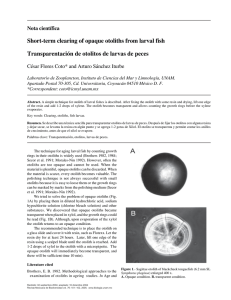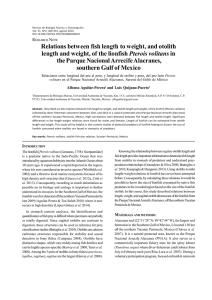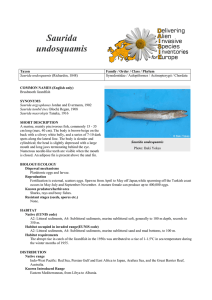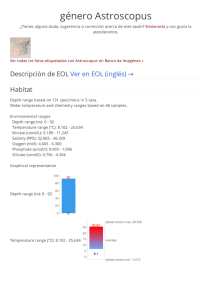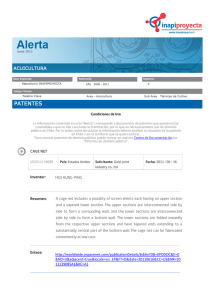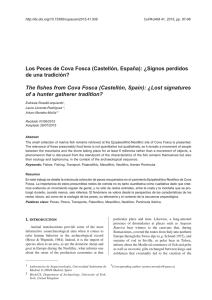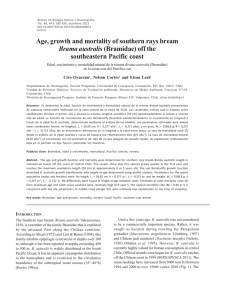oToLITh ECo-MoRPhoLogICAL PATTERNS oF BENThIC FIShES
Anuncio
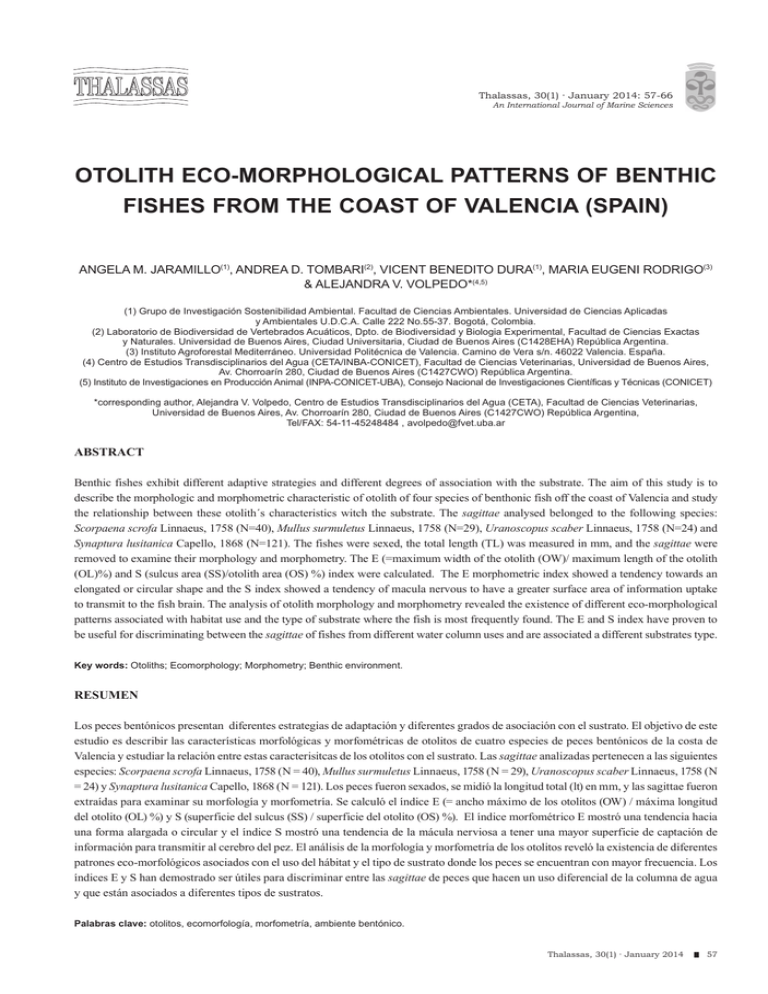
Thalassas, 30(1) · January 2014: 57-66 An International Journal of Marine Sciences OTOLITH ECO-MORPHOLOGICAL PATTERNS OF BENTHIC FISHES FROM THE COAST OF VALENCIA (SPAIN) ANGELA M. JARAMILLO(1), ANDREA D. TOMBARI(2), VICENT BENEDITO DURA(1), MARIA EUGENI RODRIGO(3) & ALEJANDRA V. VOLPEDO*(4,5) (1) Grupo de Investigación Sostenibilidad Ambiental. Facultad de Ciencias Ambientales. Universidad de Ciencias Aplicadas y Ambientales U.D.C.A. Calle 222 No.55-37. Bogotá, Colombia. (2) Laboratorio de Biodiversidad de Vertebrados Acuáticos, Dpto. de Biodiversidad y Biologia Experimental, Facultad de Ciencias Exactas y Naturales. Universidad de Buenos Aires, Ciudad Universitaria, Ciudad de Buenos Aires (C1428EHA) República Argentina. (3) Instituto Agroforestal Mediterráneo. Universidad Politécnica de Valencia. Camino de Vera s/n. 46022 Valencia. España. (4) Centro de Estudios Transdisciplinarios del Agua (CETA/INBA-CONICET), Facultad de Ciencias Veterinarias, Universidad de Buenos Aires, Av. Chorroarín 280, Ciudad de Buenos Aires (C1427CWO) República Argentina. (5) Instituto de Investigaciones en Producción Animal (INPA-CONICET-UBA), Consejo Nacional de Investigaciones Científicas y Técnicas (CONICET) *corresponding author, Alejandra V. Volpedo, Centro de Estudios Transdisciplinarios del Agua (CETA), Facultad de Ciencias Veterinarias, Universidad de Buenos Aires, Av. Chorroarín 280, Ciudad de Buenos Aires (C1427CWO) República Argentina, Tel/FAX: 54-11-45248484 , avolpedo@fvet.uba.ar ABSTRACT Benthic fishes exhibit different adaptive strategies and different degrees of association with the substrate. The aim of this study is to describe the morphologic and morphometric characteristic of otolith of four species of benthonic fish off the coast of Valencia and study the relationship between these otolith´s characteristics witch the substrate. The sagittae analysed belonged to the following species: Scorpaena scrofa Linnaeus, 1758 (N=40), Mullus surmuletus Linnaeus, 1758 (N=29), Uranoscopus scaber Linnaeus, 1758 (N=24) and Synaptura lusitanica Capello, 1868 (N=121). The fishes were sexed, the total length (TL) was measured in mm, and the sagittae were removed to examine their morphology and morphometry. The E (=maximum width of the otolith (OW)/ maximum length of the otolith (OL)%) and S (sulcus area (SS)/otolith area (OS) %) index were calculated. The E morphometric index showed a tendency towards an elongated or circular shape and the S index showed a tendency of macula nervous to have a greater surface area of information uptake to transmit to the fish brain. The analysis of otolith morphology and morphometry revealed the existence of different eco-morphological patterns associated with habitat use and the type of substrate where the fish is most frequently found. The E and S index have proven to be useful for discriminating between the sagittae of fishes from different water column uses and are associated a different substrates type. Key words: Otoliths; Ecomorphology; Morphometry; Benthic environment. RESUMEN Los peces bentónicos presentan diferentes estrategias de adaptación y diferentes grados de asociación con el sustrato. El objetivo de este estudio es describir las características morfológicas y morfométricas de otolitos de cuatro especies de peces bentónicos de la costa de Valencia y estudiar la relación entre estas caracterisitcas de los otolitos con el sustrato. Las sagittae analizadas pertenecen a las siguientes especies: Scorpaena scrofa Linnaeus, 1758 (N = 40), Mullus surmuletus Linnaeus, 1758 (N = 29), Uranoscopus scaber Linnaeus, 1758 (N = 24) y Synaptura lusitanica Capello, 1868 (N = 121). Los peces fueron sexados, se midió la longitud total (lt) en mm, y las sagittae fueron extraídas para examinar su morfología y morfometría. Se calculó el índice E (= ancho máximo de los otolitos (OW) / máxima longitud del otolito (OL) %) y S (superficie del sulcus (SS) / superficie del otolito (OS) %). El índice morfométrico E mostró una tendencia hacia una forma alargada o circular y el índice S mostró una tendencia de la mácula nerviosa a tener una mayor superficie de captación de información para transmitir al cerebro del pez. El análisis de la morfología y morfometría de los otolitos reveló la existencia de diferentes patrones eco-morfológicos asociados con el uso del hábitat y el tipo de sustrato donde los peces se encuentran con mayor frecuencia. Los índices E y S han demostrado ser útiles para discriminar entre las sagittae de peces que hacen un uso diferencial de la columna de agua y que están asociados a diferentes tipos de sustratos. Palabras clave: otolitos, ecomorfología, morfometría, ambiente bentónico. Thalassas, 30(1) · January 2014 57 ANGELA M. JARAMILLO, ANDREA D. TOMBARI, VICENT BENEDITO DURA, MARIA EUGENI RODRIGO & ALEJANDRA V. VOLPEDO Figure 1. Figure 1: Study area. Introduction Benthic fishes exhibit different adaptive strategies and different degree of association with the substrate. This association mainly depends on the type of substrate and on the morphology, physiology and behaviour of the fish (Lindsey 1978; Menni 1983). In general, fishes living on soft substrate (slimy and sandy substrates) burrow partially in the bottom while stalking prey. Most of these predators, such as the Pleuronectiformes, are characterised by rapid and short-distance movements. Fishes found on hard substrate (rocky substrate) hide in holes or stand motionless, waiting for the prey to approach. These are represented by the Scorpaeniformes and Serranids, and other fish families. The differences in habitat use and the different communication strategies of fishes may also affect different structures as the otolith sagittae (Cruz and Lombarte 2004; Lombarte and Cruz 2007; Lombarte et al. 2010). Otoliths are three paired of calcified structures (sagittae, lapilli and asterici) found in the inner ear, used for balance and/or hearing in all teleost fishes. The otolith shape is species-specific. Environmental factors (Aguirre and Lombarte 1999; Torres et al. 2000; Gauldie and Crampton 2002; Volpedo and Echeverría 2003; Volpedo et al. 200; Volpedo and Fuchs 2010), ontogeny (Tombari et al. 2005; Gonzalez Naya et al. 2012), physiology as 58 Thalassas, 30(1) · January 2014 the hearing capabilities associated with specialization in acoustic communication (Popper and Fay 1993; Paxton 2000; Lombarte and Cruz 2007) and the phylogeny (Nolf and Tyler 2006), could affect the morphology, the morphometry and the microstructure of sagittae (Volpedo and Fernández Cirelli 2006; Volpedo et al. 2007). The literature studying the morphometric variation of the otoliths of benthic fish are limited (Volpedo and Echeverría 2003). The aim of this study is to describe the morphologic and morphometric characteristic of otolith of four 23 of Valencia species of benthonic fish off the coast (Scorpaena scrofa Linnaeus, 1758, Mullus surmuletus Linnaeus, 1758, Uranoscopus scaber Linnaeus, 1758, and Synaptura lusitanica Brito Capello, 1868), and study the relationship between these otolith´s characteristics witch the substrate. Materials and Methods The analysis was based on the sagittae of four fish species: Scorpaena scrofa (N=40), Mullus surmuletus (N=29), Uranoscopus scaber (N=24) and Synaptura lusitanica (N=121). Fish samples were mature specimens and present the typical morphological pattern of their otoliths. Between July 2004 and March 2005, fishes were caught in Bay of Cullera (39º 12’- 38º 59’ N and 0º 09’- 0º 15’W) (Fig. 1) with gillnets operated by commercial, and artisanal fishermen. Figure 2 OTOLITH ECO-MORPHOLOGICAL PATTERNS OF BENTHIC FISHES FROM THE COAST OF VALENCIA (SPAIN) Figure 2: Otolith morphology of sagittae. Antirostrum (AR), cauda (C), crenulated rim (CR), excisura (Ex), horseshoe-shaped area depression (HAD), irregular rim (IR), ostium (Os), regular rim (RR), sulcus (S) and ventral area depresion (VAD). Samples were kept at -18ºC until processing in the laboratory. The specimens were identified using appropriate keys (Corbera et al. 2000; Whitehead et al. 2001; Froese and Pauly 2008). Fishes were sexed, their total length (TL) was measured to the nearest mm, and the sagittae were removed from the otic capsules. They were prepared for examination and drawing, and measured under stereoscopic microscope to the nearest 0.1 mm. Otolith morphological description is based on the terminology proposed by Volpedo and Echeverría (2000) and Tused et al. (2008). The following morphological characters were considered in medial face: geometrical shape, type of rim, presence of rostrum, antirostrum and excisura, type of sulcus, presence of ostium and cauda and presence de area depression. In addition, the topography of the lateral face (side opposite the sulcus) was described (Fig. 2). The maximum width of the otolith (OW) and maximum length of the otolith (OL) were measured in the medial face of each right sagitta (Fig. 3). OL OS The E and S index were calculated. The E index (E = OW/OL%) was calculated to assess if the otoliths showed a tendency towards an elongated or circular shape. The S index is (SS)/(OS) %). The otolith and sulcus areas were measured using a digital image processing system. The OL*100/fish size was calculated, total length (TL, mm) was the reference for fish size. The E index and OL*100/ TL were calculated from 45 species from otolith images provided AFORO data base (http://aforo.cmima.csic.es) purposes comparatives. The statistical analysis was based on the mean values of the different parameters. The Student’s t-test (Sokal and Rolf 1987; Zar 2004) was used to compare between the length and width of the right and left sagittae and between the sagittae of males and females. A ANCOVA was used to test for significant differences in the E and S index among species, followed by the Tukey’s multiple comparison test. Linear regression analysis was performed to determine the relationship between each morphometric character (OW and OL) and fish total length (TL), and the regression parameters and the coefficient of determination (R 2) were calculated. Statistical analysis was performed using SPSS Inc., 16.0 for Windows and StatGraphics Centurion XV, version 15.2.06. Results Morphological features of sagittae OW SS Figure 3: Morphometry of otoliths. Maximum length of the otolith (OL), maximum width of the otolith (OW), otolith surface (OS), sulcus surface (SS). The sagitta of Scorpaena scrofa is elongated, with a regular dorsal rim and an irregular ventral rim. The rostrum is conspicuous and represents 28% approximately of otolith length. The excisura and antirostrum are conspicuous. The sulcus is divided into a funnel-shaped 24 rim ostium and a cauda slightly directed to the ventral distally. A ventral area depression is parallel to the sulcus. The medial face is convex and the lateral face is concave with radiating grooves (Fig. 4 A). Thalassas, 30(1) · January 2014 59 ANGELA M. JARAMILLO, ANDREA D. TOMBARI, VICENT BENEDITO DURA, MARIA EUGENI RODRIGO & ALEJANDRA V. VOLPEDO Figure 4. A B C D E Figure 4: Morphology of sagittae. A: Scorpaena scrofa. B: Mullus surmuletus, C: Uranoscopus scaber, D: left sagitta of Synaptura lusitanica, E: right sagitta of Synaptura lusitanica. Scale: 2 mm In Mullus surmuletus the sagitta is oval, with scalloped or crenulated ventral and dorsal rims; the rostrum represents 30% approximately of otolith length and the excisura has a notch. The ostium is perforated. The sulcus is open anteriorly and posteriorly, is surrounded by ventral and dorsal ridges, and divided into ostium and cauda. The ostium is funnel-shaped and the cauda is initially straight and then curves distally towards the ventral rim. It has dorsal and ventral area depressions, oriented parallel to the sulcus. The medial face is convex and the lateral face is concave and shows radiating grooves. (Fig. 4 B) The sagitta of Uranoscopus scaber is oval, with regular rims. It lacks rostrum, antirostrum or excisura. The sulcus is closed anteriorly and posteriorly and not divided into ostium and cauda. The area depression is absent. The medial and lateral faces are slightly flat, with the latter showing radiating grooves (Fig. 4 C). The left and right sagittae of Synaptura lusitanica 60 Thalassas, 30(1) · January 2014 show morphological differences. The left sagitta is oblong, with regular rims. There is a quadrangularshaped process at the postero-dorsal tip. 26 The rostrum is poorly developed and the excisura and antirostrum are short. The sulcus is open anteriorly, ostium and cauda are differentiated. The cauda is small and almost circular in the posterior part of the sulcus, and is surrounded by a horseshoe-shaped area depression. The medial face is convex and the lateral face is undulated (Fig. 4 D). The right sagitta is oblong, with irregular rims and a projection at the postero-dorsal tip. The ostium and cauda are differentiated. The collum is present between the ostium and the cauda. The horseshoe-shaped area depression is present. The medial face is convex and the lateral face is undulated (Fig. 4 E). Morphometrical features of otoliths Table 1 shows the significance of the differences in length and width between the right and left sagittae, as determined by the Student’s t-test. 58 48 OTOLITH ECO-MORPHOLOGICAL PATTERNS OF BENTHIC FISHES FROM THE COAST OF VALENCIA (SPAIN) 38 S.scrofa Figure 5 M.surmuletus U.scaber S.lusitanica A Species 98 Hard sustrate Mixed sustrate Soft sustrate 60 Sp1 50 E 78 45 68 40 Sp3 35 Sp2 25 20 S.scrofa M.surmuletus U.scaber S.lusitanica 15 A 10 Species 60 Sp1 S 30 48 38 Soft sustrate Mixed sustrate Sp3 55 Sp2 88 58 Hard sustrate Hard sustrate 55 Sp2 Mixed sustrate 5 Soft sustrate 0 Sp3 S.scrofa M.surmuletus U.scaber S.lusitanica B Species 50 Figure 5: Mean45 values and standard deviation. A) E index (E= OW/OL%). B) S index (S= SS/ OS %). sp1: species associated to soft substrate (Table 4), sp2: species 40 associated to hard substrate (Table 4), sp3: species associated to mixed substrate (Table 4). 35 In relation to fish relative Sp1 size (OL*100/TL), the S 30 otoliths of S. scrofa and U. scaber were the largest 25 and 3.03-4.83, respectively), while those of M. (4.11-4.64 surmuletus and S. lusitanica were the smallest (2.70-3.48 20 and 2.26-3.11, respectively). 15 10 The right and left sagittae of M. surmuletus, S. scrofa and U.5 scaber no showed morphological differences in B 0 S.scrofa M.surmuletus S.lusitanica the topography of the inner and outerU.scaber face of the otolith. S. lusitanica present differences Species between the right and left sagitta (Fig. 4). The results of the comparison between the sagittae of males and females are shown in Table 2. The otoliths of females of M. surmuletus, S. lusitanica and U. scaber were significantly larger than those of males of a similar length, while the otoliths of S. scrofa did not differ significantly between sexes. The regression parameters (a and b) and coefficient of determination (R2) for the relationships between the morphometric characters of the sagittae and fish total length are presented in Table 3. The regressions were significant for all species (Table 3) and data from symmetric fishes fitted well to the linear regression model (R2>0.80). The lowest values of R2 were obtained for S. lusitanica, particularly for the relationship between otolith width and fish total length. In this species showing morphologically different right and left sagittae, the values of R2 calculated from the right sagittae were higher than those from the left sagittae. The lowest and highest values of the E morphometric index were obtained for S. scrofa (40.3%) and M. sur- muletus (70.54%), respectively, while S. lusitanica and U. scaber showed similar values (55.63 % and 53.12 %, respectively) (Fig. 5 A). ANCOVA showed significant differences in the E morphometric index among the studied species (F(3;216) = 117.2; P < 0.05), and the Tukey’s multiple comparison test revealed significant differences between M. surmuletus, S. scrofa and the other species. There were no significant differences in the E morphometric index between S. lusitanica and U. scaber. The mean value of S indexes for M. surmuletus are highest (26.12 % ± 4.57) and lowest for S. scrofa (11.58% ± 3.73). S. lusitanica and U. scaber showed intermediate values (12.94% ± 3.55 % and 18.74% ± 8.32%, respectively) (Figure 5 B). 27 ANCOVA showed significant differences in the S index among studies species (F(3;216) = 107.3; P < 0.05) and the Tukey’s multiple comparison test revealed significant differences between M. surmuletus, S. scrofa and the other species. There were no significant differences in the S morphometric index between S. lusitanica and S. scrofa. Discussion The otoliths of benthic fishes from the coast of Valencia showed different eco-morphological patterns, which could be associated with the type of substrate where the fish is most frequently found and habitat use. In order to relate our results with those of the Otolith AFORO Database and have a reference in the interpretation of these, we have obtained the E index and Thalassas, 30(1) · January 2014 61 Table 1. Morphometric features (mean ± SD) of sagitta in the studied species and t-student ANGELA M. JARAMILLO, ANDREA D. TOMBARI, VICENT BENEDITO DURA, MARIA EUGENI RODRIGO & ALEJANDRA V. VOLPEDO results for comparison between right and left otolith. N. sample number, TL= fish total Table 1: legth; OL = maximum length of the otolith; OW= maximum width of the otolith. *P>0.05 Morphometric features (mean ± SD) of sagitta in the studied species and t-student results for comparison between right and left otolith. N. sample number, significative TL= fish total legth; OL = maximum length of the otolith; OW= maximum width of the otolith. *P>0.05 significative Species S. scrofa M. surmuletus U. scaber S. lusitanica TL Morphometric Right Otolith Left Otolith (mm) features (mm) (mm) 224 ± 7 OL 9.8 ± 1.6 OW 205 ± 4 234 ± 5 235 ± 4 t-value N P 9.1 ± 2.1 0.87 24 0.4 3.8 ± 0.6 3.6 ± 0.8 0.34 OL 6.3 ± 0.8 6.3 ± 0.8 0.054 OW 4.5 ± 0.5 4.4 ± 0.5 0.705 OL 9.2 ± 2.1 9.2 ± 2.1 0.087 OW 4.9 ± 0.9 4.8 ± 0.9 0.097 OL 6.3 ± 1.0 5.9 ± 1.1 2.56 OW 3.4 ± 0.5 3.7 ± 0.8 2.91 0.7 20 0.9 0.5 24 0.9 0.9 121 < 0.05* < 0.05* substrates is 79.09% ±8.37 and S 20.13 ± 12.7 %. In the case of species associated with hard substrates have an average of E index of 48.47% ±5.23 and S 35.43±20.11 %., while the 10 species associated both to mixed substrates have an average of 56.20% ±5.81 and S 34.63±23.6 %. the relative sizes of the otoliths in relation to the TL, from 45 species of western Mediterranean, north and central eastern Atlantic fishes (Tuset et al. 2008; Otolith AFORO Database 2012). The data are shown in table 4. In table 4, of the 45 species, 18 species inhabit soft species of of Bothidae, substrates, 17 hard substrates andbetween 10 speciesmorphometric are associated features The Table 2. Comparison (mean ± SD) sagitta Cynoglossidae, of both sex Gobiidae and Soleidae families generally present otolith with the E to mixed substrates (hard and soft) (Fischer et al. 2007). index valuesOW= >60%maximum and are associated soft substrates The average of the E index of species withlength soft of the and t-student results. OL =associated maximum otolith; width ofto the otolith. *P>0.05 significative Table 2: Comparison between morphometric features (mean ± SD) of sagitta of both sex and t-student results. OL = maximum length of the otolith; OW= maximum width of the otolith. *P>0.05 significative. Species Morphometric Female Male features (mm) (mm) OL 9.8 ± 1.7 OW S. scrofa M. surmuletus U. scaber S. lusitanica 62 Thalassas, 30(1) · January 2014 t-values g.l. P 9.7 ± 1.6 0.17 24 0.87 3.8 ± 0.6 4.0 ± 0.8 0.98 OL 6.7 ± 0.6 5.8 ± 0.5 3.1 OW 4.7 ± 0.5 4.2 ± 0.5 2.23 OL 9.9 ± 2.2 9.1 ± 1.2 3.01 OW 5.2 ± 1.0 4.4 ± 0.6 2.9 OL 6.3 ± 1.1 5.7 ± 0.7 3.4 OW 3.7 ± 0.7 3.3 ± 0.5 4.03 16 0.33 20 < 0.05* < 0.05* 40 < 0.05* < 0.05* 121 < 0.05* < 0.05* Table 3. Regression linealOTOLITH parameters pf morphometrical features of sagitta in relation to ECO-MORPHOLOGICAL PATTERNS OF BENTHIC FISHES FROM THE COAST OF VALENCIA (SPAIN) total length of fish. a: intercept, b: slope, R2: determination coefficient. LOL. left otolith length, LOW left otolith width, OL: right length otolith, OW: right otolith width, TL. Total Table 3: Regression lineal parameters pf morphometrical features of sagitta in relation to total length of fish. a: intercept, b: slope, R2: determination coefficient. LOL. length of fish. left otolith length, LOW left otolith width, OL: right length otolith, OW: right Specie otolith width, TL. Total length of fish. a b R2 TL vs OL 3.40 0.26 0.87 TL vs OW 1.17 0.11 0.88 TL vs OL 2.76 0.17 0.81 TL vs OW 1.17 0.13 0.84 TL vs OL -0.43 0.41 0.87 TL vs OW 0.30 0.19 0.88 TL vs OL 0.36 0.25 0.85 TL vs LOL -0.02 0.25 0.62 TL vs OW 1.15 0.09 0.40 TL vs LOW 0.83 0.12 0.25 Morphometrical features S. scrofa M. surmuletus U. scaber S. lusitanica and S index values between 10.38-53.16 %. The species of Muraenidae, Scorpaenidae, Serranidae, Trachinidae and Tripterygiidae families present otolith with the E index values <60% and S index values between 13.25-32.91 and are associated to hard substrates. The labrids, mullids and sparids present species associated to soft substrates and hard substrates (Table 4). Xyrichthys novacula (labrids) present an E index value of 89.41% inhabiting soft substrate, while the labrids associated to hard substrate (Table 4) present E index values between 50.00-55.11%. Mullus barbatus barbatus present an E index value of 75.96% inhabinting sof substrates (Fischer et al. 2007). The sparid species of soft bottom (Dentex macrophthalmus) present E index values of 80.46 %, and sparid species of hard bottom (Dentex dentex) E index values of 57.44% (Table 4). The fishes burrowing into soft bottom substrates (U. scaber and S. lusitanica), have oblong otoliths of variable size in relation to fish total length and an E morphometric index with 53.12% and 55.63%. This species inhabit sandy or muddy bottoms between 10 to 90 m deep, feeding off small fish, crustaceans, molluscs and polychaetes (Calvin 2000, Jaramillo 2009). U. scaber and S lusitanica shared similar habitat, however the latter is a trophic specialist, predating predominantly on polychaetes (Jaramillo 2009). As the E and the S indexes are similar it can be suggested that otolith morphology and morphometry reflected the similarities between U. scaber and S lusitanica habitat characteristics and behavior. These relationships established for other species of different habitats (Volpedo and Echeverria 2003; Volpedo et al. 2008; Cruz and Lombarte 2004; Lombarte and Cruz 2007). The otolith of S. lusitanica shows a horseshoe-shaped area depression, which results from cranial remodelling and eye migration during larval metamorphosis. This feature is shared by other flatfishes such as Achiropsetta tricholpis Norman, 1930, Etropus longimanus Norman, 1933, Paralichthys orbynianus (Valenciennes, 1839), P.isosceles Jordan, 1891, P. brasiliencies (Ranzani, 1842), P. patagonicus Jordan, 1889 and Xystreuris rasile Jordan, 1891 (Volpedo and Echeverría 1997). S. scrofa is present on hard bottoms, and M. surmuletus is found on mixed bottoms (soft and hard substrates), both species showed a different morphological pattern in their otoliths and water column used. S. scrofa18 is a solitary fish common on hard substrate and in caves, and it may move to sandy bottom sediments despite its sedentary behaviour (Corbera et al. 2000). The otolith of this species is 4.5% of fish total length, with an E index of 40.3%, and the S index (11.58%) is the lowest value of studied species in this paper. The otolith of S. scrofa is elongated shape and well-developed rostrum are also present in other species of the genus such as S. elongata, S. maderensis, S. notata and S. porcus (Tuset et al. 2008), and in hardbottom serranid and notothenid fishes (Volpedo and Echeverría 2003). Thalassas, 30(1) · January 2014 63 ANGELA M. JARAMILLO, ANDREA D. TOMBARI, VICENT BENEDITO DURA, MARIA EUGENI RODRIGO & ALEJANDRA V. VOLPEDO ANGELA M. JARAMILLO, ANDREA D. TOMBARI, VICENT BENEDITO DURA, MARIA EUGENI RODRIGO & ALEJANDRA V. VOLPEDO Table 4. E index and OL/TL relation in species of literature.1-soft substrate, 2: hard 4: substrate,3: mixed bottoms (soft and hardTable substrates). Table 4: E index and OL/TL relation in species of literature.1-soft substrate, 2: hard substrate,3: mixed bottoms (soft and hard substrates). E index and OL/TL relation in species of literature.1-soft substrate, 2: hard substrate,3: mixed bottoms (soft and hard substrates). Family E% (OL*100)/TL SS/OS% Substrate Arnoglossus imperialis (Rafinesque, 1810) 69.70 1.886 30.493 1 Arnoglossus laterna (Walbaum, 1792) 66.67 2.371 24.691 1 Arnoglossus rueppelii (Cocco, 1844) 67.77 2.305 24.585 1 Arnoglossus thori Kyle, 1913 64.94 3.138 53.165 1 Bothus podas (Delaroche, 1809) 66.93 1.434 28.097 1 Callionymus maculatus Rafinesque, 1810 47.80 2.661 54.762 3 Callionymus risso Lesueur, 1814 49.86 2.823 53.126 3 Synchiropus phaeton (Günther, 1861) 47.81 2.314 20.408 3 Cepolidae Cepola macrophthalma (Linnaeus, 1758) 55.10 2.305 20.719 3 Citharidae Citharus linguatula (Linnaeus, 1758) 61.60 3.035 17.580 3 Cynoglossidae Symphurus ligulatus (Cocco, 1844) 80.72 3.557 12.032 1 Symphurus nigrescens Rafinesque, 1810 87.17 1.965 15.741 1 Deltentosteus quadrimaculatus (Valenciennes, 1837) 84.22 4.444 10.578 1 Gobius niger Linnaeus, 1758 78.04 4.549 10.384 1 Lesueurigobius friesii (Malm, 1874) 87.27 4.650 10.601 1 Mullidae Mullus barbatus barbatus Linnaeus, 1758 75.96 2.176 18.636 1 Soleidae Bathysolea profundicola (Vaillant, 1888) 85.51 2.070 14.38 1 Monochirus hispidus Rafinesque, 1814 85.51 2.070 24.27 1 Pegusa lascaris (Risso, 1810) 91.47 2.413 13.62 1 Solea senegalensis Kaup, 1858 82.66 2.464 19.72 1 Solea solea (Linnaeus, 1758) 79.19 1.700 13.61 1 Lithognathus mormyrus (Linnaeus, 1758) 59.91 3.531 20.303 3 Dentex macrophthalmus (Bloch, 1791) 80.46 4.894 14.090 1 Trachinus draco Linnaeus, 1758 47.58 4.935 17.045 2 Trachinus radiatus Cuvier, 1829 48.62 3.828 19.153 2 Coris julis (Linnaeus, 1758) 55.11 1.957 18.135 2 Labrus merula Linnaeus, 1758 50.00 1.726 14.250 2 Labrus viridis Linnaeus, 1758 51.35 1.930 14.620 2 Symphodus cinereus (Bonnaterre, 1788) 62.79 1.911 7.210 3 Symphodus doderleini Jordan, 1890 55.02 2.544 16.080 3 Symphodus mediterraneus (Linnaeus, 1758) 56.60 2.136 9.434 3 Symphodus ocellatus (Linnaeus, 1758) 65.58 1.925 7.339 3 Symphodus rostratus (Bloch, 1791) 60.09 2.027 6.874 2 Symphodus tinca (Linnaeus, 1758) 56.13 1.843 5.893 2 Xyrichthys novacula (Linnaeus, 1758) 89.41 2.040 18.750 1 Muraenidae Muraena helena Linnaeus, 1758 44.25 0.718 32.915 2 Scorpaenidae Helicolenus dactylopterus (Delaroche, 1809) 50.64 4.542 23.552 2 Scorpaena elongata Cadenat, 1943 40.30 5.448 16.071 2 Scorpaena notata Rafinesque, 1810 43.12 5.508 21.278 2 Scorpaena porcus Linnaeus, 1758 42.96 4.656 13.252 2 Epinephelus marginatus (Lowe, 1834) 48.57 2.714 28.820 2 Serranus cabrilla (Linnaeus, 1758) 42.31 4.160 23.909 2 Serranus scriba (Linnaeus, 1758) 43.54 3.388 30.073 2 57.44 3.186 13.985 2 44.37 1.603 17.620 2 Bothidae Callionymidae Gobiidae Sparidae Trachinidae Labridae. Serranidae 64 64 Specie Thalassas, 30(1) · January 2014 Sparidae Thalassas, 30(1) · January 2014 Dentex dentex (Linnaeus, 1758) Tripterygiidae Tripterygion delaisi Cadenat & Blache, 1970 19 OTOLITH ECO-MORPHOLOGICAL PATTERNS OF BENTHIC FISHES FROM THE COAST OF VALENCIA (SPAIN) M. surmuletus mainly inhabits mixed bottoms (rocky bottoms and soft substrates), and undergoes vertical movements between 5 and 100 m in depth (Froese and Pauly 2008). This species showed the highest value of E and S indexes (70.54% and 26.13%, respectively), which may be explained by a differential use of the water column. The indexes values obtained for M. surmuletus are similar at de values determinate by Volpedo et al. (2008) in mesopelagic Antarctic fishes that make extensive vertical migrations and other Mediterranean fishes species that using soft and hard substrates (table 4). The high value of S index could be associated with water column uses, this could be a support for adaptive physiological features as specialization in acoustic communication in deep waters in order to compensate the reduction of light with depth (Lombarte and Cruz 2007), among other factors. The otolith morphology of this species (geometric shape, type of rims, presence of rostrum, and type of sulcus) is similar to that of other species of the same genus such as M. barbatus, M. mullus and M. argentinae Hubbs, Marini & Hubbs, 1933 (Volpedo and Echeverría 2000; Tuset et al. 2008). The differences in otolith morphometry observed between males and females of M. surmuletus, S. lusitanica and U. scaber were also found for Prionotus nudigula Ginsburg, 1950 (Volpedo and Thompson 1998). This result may be due to the fact that these species are sexually dimorphic in size, with females growing at a lower rate and being larger than males (Reñones et al. 1995; Jaramillo 2009). According to Volpedo and Echeverría (2003), the differences in the E and S index among fish species may be due not only to phylogenetic factors but also to environmental and bioecological factors. In this work, the E and S index have proven to be useful for discriminating between the sagittae of fishes from different substrate. On this basis, it can be seen as a valuable tool for studies of trophic ecology in the coast of Valencia. This work contributed to the knowledge of the bioecology of commercially important benthic fishes and provided key information for studying the trophic ecology of fish-eating species and fishery management. Acknowledgments We are grateful to the “Conselleria de Territori I Habitatge. Generalitat Valenciana”, to the Universidad de Buenos Aires (UBACYT 20620110100007), to the National Scientific and Technical Research Council (CONICET) and ANPCYT (PICT N° 2010-1372) for the financial support to this project. The authors grateful to C. Assis for critical revision of manuscript and for their comments, and G.E. Comte for the technical support in images analyzed. References Aguirre H, Lombarte A (1999). Ecomorphologic comparisons of sagittae in Mullus barbatus and M. surmuletus. Journal of Fish Biology, 55: 105-114. Calvin JC (2000) El ecosistema marino mediterráneo guía de su flora y fauna 2°Ed. Juan Carlos Calvin Calvo, Murcia, España, 797 pp. Corbera J, Sabatés A, García-Rubies A (2000). Peces de Mar de la Península Ibérica. Guía de Campo. Ed. Planeta, Barcelona. 75 pp. Cruz A, Lombarte A (2004). Otolith size and its relationship with colour pattern and sound production. Journal of Fish Biology, 65: 1512–1525. Fischer ST, Patzner RA, Müller CHG, Winkler HM (2007). Studies on the ichthyofauna of the coastal waters of Ibiza (Balearic Islands, Spain). Rostocker Meeresbiologische Beiträge 18: S. 30-62 Froese R, Pauly D. (eds.) (2008). FishBase. World Wide Web electronic publication. www.fishbase.org, version (02/2008). Gauldie RW, Crampton JS (2002). An ecomorphological explication of individual variability in the shape of the fish otolith: comparison of the otolith of Hoplostethus atlanticus with other species by depth. Journal of Fish Biology, 60: 1221–1240. Gonzalez Naya MJ, Tombari A, Volpedo AV, Gómez SE (2012). Size related changes in sagitta otoliths of Australoheros facetus (Pisces; Cichlidae) from South America. Journal of Applied Ichthyology, 725-755 Jaramillo A (2009). Estudio de la biología trófica de cinco especies de peces bentónicos de la costa de Cullera. Relaciones con la acumulación de metales pesados. Ph.D. thesis, Univ. Politécnica Valencia. Lindsey CC (1978). Form, function, and locomotory habits in fish. In: Hoar WS, Randall DJ. (Eds.) Fish physiology. Vol. II. Academic Press, New York, 100 pp. Lombarte A, Cruz A (2007). Otolith size trends in marine fish communities from different depth strata. Journal of Fish Biology, 71 (1): 53-76. Lombarte A, Palmer M, Matallanas J, Gómez-Zurita J, MoralesNin B (2010). Ecomorphological trends and phylogenetic inertia of otolith sagittae in Nototheniidae. Environmental Biology of Fishes, 89:607-618. Menni RC (1983). Los peces en el medio marino. Estudio Sigma SRL. Argentina, 171 pp. Nolf D, Tyler H (2006). Otolith evidence concerning interrelationship of caproid zeiform and tetradontiform fishes. Bulletin de l’Institut Royal des Sciences Naturelles de Belgique, 76: 147-189. Paxton JR (2000). Fish otoliths: do sizes correlate with taxonomic group, habitat and/ or luminescence? Philosophical Thalassas, 30(1) · January 2014 65 Transactions of the Royal Society B: Biological Sciences 355: 1299–1303. Popper AN, Fay RR (1993). Sound detection and processing by fish: critical review and major research questions. Brain Behavior and Evolution, 41: 14-38. Reñones O, Massutí E, Morales-Nin B (1995). Life history of red mullet (Mullus surmuletus) from the bottom-trawl fishery off the island of Mallorca (NW Mediterranean). Marine Biology, 123: 411-419. Sokal RR, Rolf FL (1987). Introduction to biostatistics, 2nd Edition. Freeman, New York, 887 pp. Tombari AD, Volpedo AV, Echeverría DD ( 2005). Desarrollo de la sagitta en juveniles y adultos de Odontesthes argentinensis (Valenciennes, 1835) y Odontesthes bonariensis (Valenciennes, 1835) de la provincia de Buenos Aires, Argentina (Teleostei: Atheriniformes). Revista Chilena de Historia Natural, 78:623-633. Torres GJ, Lombarte A, Morales-Nin (2000). Variability of the sulcus acusticus in the sagittal otolith of the genus Merluccius (Merluccidae). Fisheries Research, 46: 5–13. Tuset VM, Lombarte A, Assis CA (2008). Otolith atlas for the Western Mediterranean, North and Central Eastern Atlantic. Scientia Marina, 72 (S1): 7-198. Volpedo AV, Echeverría DD (1997). Morfología de la sagitta de lenguados del Mar Argentino (Pisces: Pleuronectiformes). Thalassas, 13: 113-126. Volpedo AV, Thompson GA (1998). Diferencias en el crecimiento de las sagittae de Prionotus nudigula Ginsburg, 1950 (Pisces: Triglidae) en relación al sexo. Boletín del Instituto Español de Oceanografía, 12(1): 3-16. Volpedo AV, Echeverría DD (2000). Catálogo y claves de otolitos para la identificación de peces del mar argentino. 1. Peces de importancia económica. Dunken, Buenos Aires, 88 pp. Volpedo AV, Echeverría DD ( 2003). Ecomorphological patterns of the sagitta in fish on the continental shelf off Argentine. Fisheries Research, 60: 551-560. Volpedo AV, Fernández Cirelli A ( 2006). Otolith chemical composition as a useful tool for sciaenids stock discrimination in Southwestern Atlantic. Scientia Marina, 70 (2): 325-334. Volpedo AV, Miretzky P, Fernández Cirelli A (2007). Stocks pesqueros de Cynoscion guatucupa y Micropogonias furnieri de la costa atlántica de Sudamérica: comparación entre métodos de identificación. Memoria de la Fundacion La Salle de Ciencias Naturales, 165: 115-130. Volpedo AV, Tombari AD, Echeverría DD (2008). Ecomorphological patterns of the sagitta of Antarctic fish. Polar Biology, 31 (5): 635-640. Volpedo AV, Fuchs DV (2010). Ecomorphological patterns of the lapilli of Paranoplatense Siluriforms (South America). Fisheries Research, 102: 160-165. Whitehead PJP, Bauchot ML, Hureau JC, Nielson J, Tortonese T (Eds) (2001). Fishes of the north-eastern Atlantic and the Mediterranean. World Biodiversity Database CD-ROM Series. ETI UNESCO, Amsterdam. Zar J (2004). Biostatistical Analysis. Fourth Edition. Prentice Hall International, INC. New Jersey, USA, 663 pp. (Received: July, 15, 2013; Acepted: October, 24, 2013) 66 Thalassas, 30(1) · January 2014
